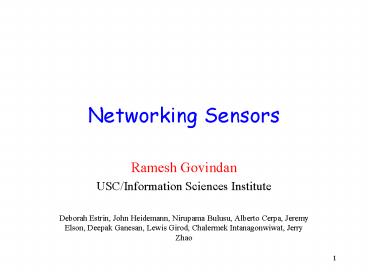Networking Sensors - PowerPoint PPT Presentation
1 / 18
Title:
Networking Sensors
Description:
Application-specific, data-centric networks. Data processing/aggregation inside the network ... algorithms must auto-scale. outlier indicators are different ... – PowerPoint PPT presentation
Number of Views:21
Avg rating:3.0/5.0
Title: Networking Sensors
1
Networking Sensors
- Ramesh Govindan
- USC/Information Sciences Institute
- Deborah Estrin, John Heidemann, Nirupama Bulusu,
Alberto Cerpa, Jeremy Elson, Deepak Ganesan,
Lewis Girod, Chalermek Intanagonwiwat, Jerry Zhao
2
The Goal
- Embed numerous devices to monitor and interact
with physical world - Network these devices so that they can coordinate
to perform higher-level tasks - Requires robust distributed systems of tens of
thousands of devices
3
The Challenge Dynamics!
- The physical world is dynamic
- Dynamic operating conditions
- Dynamic availability of resources
- particularly energy!
- Dynamic tasks
- Devices must adapt automatically to the
environment - Too many devices for manual configuration
- Environmental conditions are unpredictable
- Unattended and un-tethered operation is key to
many applications
4
Design Considerations
- Energy is the bottleneck resource
- Avoid communication over long distances
- Cannot assume global knowledge, cannot
pre-configure networks - Achieve desired global behavior through localized
interactions - Empirically adapt to observed environment
- Can leverage
- Small-form-factor nodes, densely distributed to
achieve physical locality to sensed phenomena - Application-specific, data-centric networks
- Data processing/aggregation inside the network
5
One Approach Directed Diffusion
- Application-aware communication primitives
- expressed in terms of named data (not in terms of
the nodes generating or requesting data) - Consumer of data initiates interest in data with
certain attributes - Nodes diffuse the interest towards producers via
a sequence of local interactions - This process sets up gradients in the network
which channel the delivery of data - Reinforcement and negative reinforcement used to
converge to efficient distribution - Intermediate nodes opportunistically fuse
interests, aggregate, correlate or cache data
6
Illustrating Directed Diffusion
Setting up gradients
Source
Sink
Source
Sink
Recovering from node failure
7
Local Behavior Choices
- For propagating interests
- In our example, flood
- More sophisticated behaviors possible e.g. based
on cached information, GPS - For setting up gradients
- Highest gradient towards neighbor from whom we
first heard interest - Others possible towards neighbor with highest
energy
- For data transmission
- Different local rules can result in single path
delivery, striped multi-path delivery, single
source to multiple sinks and so on. - For reinforcement
- reinforce one path, or part thereof, based on
observed losses, delay variances etc. - other variants inhibit certain paths because
resource levels are low
8
Initial simulation study of diffusion
- Compare diffusion to
- flooding
- centrally computed tree (omniscient multicast)
- Key metrics
- Average Dissipated Energy per event delivered
- indicates energy efficiency and network lifetime
- Delay
- indicates the temporal accuracy of information
- Event Delivery Ratio
- indicates the robustness
9
Diffusion Simulation Details
- Network Size 50-250 Nodes
- Constant Density 1.95e-3 nodes/m2
- To factor out the impact of increased
connectivity - Transmission Range 40m
- MAC IEEE802.11
- Not a completely satisfactory choice due to power
consumption during idle intervals - Energy Model Mimic the realistic sensor radio
Pottie 2000 - Power consumption in transmission 660 mW
- Power consumption in reception 395 mW
- Power consumption during idle intervals 35 mW
10
Diffusion Simulation
- Surveillance application
- 5 sources are randomly selected within a 70m x
70m corner in the field - 5 sinks are randomly selected across the field
- High data rate is 2 events/sec
- Low data rate is 0.2 events/sec
- Event size 64 bytes
- Interest size 36 bytes
- All sources send the same location estimate for
base experiments
11
Average Dissipated Energy
0.018
0.016
Flooding
0.014
0.012
0.01
0.008
(Joules/Node/Received Event)
Omniscient Multicast
Average Dissipated Energy
0.006
Diffusion
0.004
0.002
0
0
50
100
150
200
250
300
Network Size
12
Delay
0.35
0.3
0.25
Flooding
0.2
Delay (secs)
0.15
0.1
0.05
Diffusion
Omniscient Multicast
0
0
50
100
150
200
250
300
Network Size
13
Impact of Negative Reinforcement
0.012
0.01
Without Negative Reinforcement
0.008
Average Dissipated Energy
(Joules/Node/Received Event)
0.006
With Negative Reinforcement
0.004
0.002
0
0
50
100
150
200
250
300
Network Size
14
Impact of Duplicate Suppression
0.025
0.02
Without Suppression
0.015
(Joules/Node/Received Event)
Average Dissipated Energy
0.01
With Suppression
0.005
0
0
50
100
150
200
250
300
Network Size
15
Domination of Idle Energy
0.14
Diffusion
0.12
Flooding
Omniscient Multicast
0.1
0.08
Average Dissipated Energy
(Joules/Node/Received Event)
0.06
0.04
0.02
0
0
50
100
150
200
250
300
Network Size
16
Summary of Diffusion Results
- Under the investigated scenarios, diffusion
outperformed omniscient multicast and flooding - All layers have to be carefully designed
- Not only network layer but also MAC and
application level - Application-level data dissemination has the
potential to improve energy efficiency
significantly - Duplicate suppression is only one simple example
out of many possible ways. - Aggregation
17
Sensor Network Tomography
- Continuously updated indication of sensor network
health - Useful for
- performance tuning
- adjusting sensing thresholds
- incremental deployment
- refurbishing sections of sensor field with
additional resources - self testing
- validating sensor field response to known input
Tomogram indicating connection quality
18
Sensor Network Tomography Key Ideas and
Challenges
- Kinds of tomograms
- network health
- resource-level indicators
- responses to external stimuli
- Can exchange resource health
- during low-level housekeeping functions
- such as radio synchronization
- Key challenge energy-efficiency
- need to aggregate local representations
- algorithms must auto-scale
- outlier indicators are different































